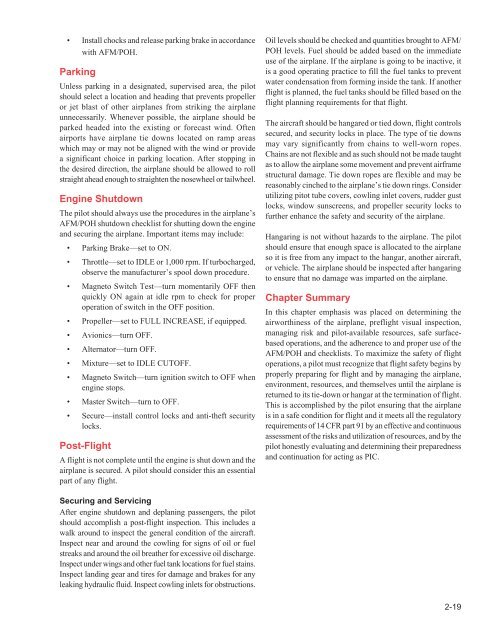You also want an ePaper? Increase the reach of your titles
YUMPU automatically turns print PDFs into web optimized ePapers that Google loves.
• Install chocks and release parking brake in accordance<br />
with AFM/POH.<br />
Parking<br />
Unless parking in a designated, supervised area, the pilot<br />
should select a location and heading that prevents propeller<br />
or jet blast of other airplanes from striking the airplane<br />
unnecessarily. Whenever possible, the airplane should be<br />
parked headed into the existing or forecast wind. Often<br />
airports have airplane tie downs located on ramp areas<br />
which may or may not be aligned with the wind or provide<br />
a significant choice in parking location. After stopping in<br />
the desired direction, the airplane should be allowed to roll<br />
straight ahead enough to straighten the nosewheel or tailwheel.<br />
Engine Shutdown<br />
The pilot should always use the procedures in the airplane’s<br />
AFM/POH shutdown checklist for shutting down the engine<br />
and securing the airplane. Important items may include:<br />
• Parking Brake—set to ON.<br />
• Throttle—set to IDLE or 1,000 rpm. If turbocharged,<br />
observe the manufacturer’s spool down procedure.<br />
• Magneto Switch Test—turn momentarily OFF then<br />
quickly ON again at idle rpm to check for proper<br />
operation of switch in the OFF position.<br />
• Propeller—set to FULL INCREASE, if equipped.<br />
• Avionics—turn OFF.<br />
• Alternator—turn OFF.<br />
• Mixture—set to IDLE CUTOFF.<br />
• Magneto Switch—turn ignition switch to OFF when<br />
engine stops.<br />
• Master Switch—turn to OFF.<br />
• Secure—install control locks and anti-theft security<br />
locks.<br />
Post-Flight<br />
A flight is not complete until the engine is shut down and the<br />
airplane is secured. A pilot should consider this an essential<br />
part of any flight.<br />
Oil levels should be checked and quantities brought to AFM/<br />
POH levels. Fuel should be added based on the immediate<br />
use of the airplane. If the airplane is going to be inactive, it<br />
is a good operating practice to fill the fuel tanks to prevent<br />
water condensation from forming inside the tank. If another<br />
flight is planned, the fuel tanks should be filled based on the<br />
flight planning requirements for that flight.<br />
The aircraft should be hangared or tied down, flight controls<br />
secured, and security locks in place. The type of tie downs<br />
may vary significantly from chains to well-worn ropes.<br />
Chains are not flexible and as such should not be made taught<br />
as to allow the airplane some movement and prevent airframe<br />
structural damage. Tie down ropes are flexible and may be<br />
reasonably cinched to the airplane’s tie down rings. Consider<br />
utilizing pitot tube covers, cowling inlet covers, rudder gust<br />
locks, window sunscreens, and propeller security locks to<br />
further enhance the safety and security of the airplane.<br />
Hangaring is not without hazards to the airplane. The pilot<br />
should ensure that enough space is allocated to the airplane<br />
so it is free from any impact to the hangar, another aircraft,<br />
or vehicle. The airplane should be inspected after hangaring<br />
to ensure that no damage was imparted on the airplane.<br />
Chapter Summary<br />
In this chapter emphasis was placed on determining the<br />
airworthiness of the airplane, preflight visual inspection,<br />
managing risk and pilot-available resources, safe surfacebased<br />
operations, and the adherence to and proper use of the<br />
AFM/POH and checklists. To maximize the safety of flight<br />
operations, a pilot must recognize that flight safety begins by<br />
properly preparing for flight and by managing the airplane,<br />
environment, resources, and themselves until the airplane is<br />
returned to its tie-down or hangar at the termination of flight.<br />
This is accomplished by the pilot ensuring that the airplane<br />
is in a safe condition for flight and it meets all the regulatory<br />
requirements of 14 CFR part 91 by an effective and continuous<br />
assessment of the risks and utilization of resources, and by the<br />
pilot honestly evaluating and determining their preparedness<br />
and continuation for acting as PIC.<br />
Securing and Servicing<br />
After engine shutdown and deplaning passengers, the pilot<br />
should accomplish a post-flight inspection. This includes a<br />
walk around to inspect the general condition of the aircraft.<br />
Inspect near and around the cowling for signs of oil or fuel<br />
streaks and around the oil breather for excessive oil discharge.<br />
Inspect under wings and other fuel tank locations for fuel stains.<br />
Inspect landing gear and tires for damage and brakes for any<br />
leaking hydraulic fluid. Inspect cowling inlets for obstructions.<br />
2-19


